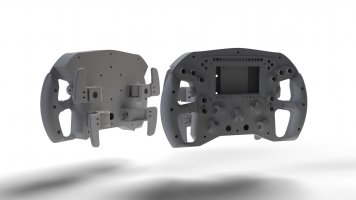Hello everyone! I decided to design my own wheel and I'm trying to understand the diferences in Arduino models for what I need. At first I was decided on using a Mega 2560 as it had a lot of pins and seemed to be the best choice to keep it organized as I don't want to use a button matrix.
I started sketching it on SimHub and came across a warning on the Wiki that said only Micro Pro boards are seen as gamepad on the game itself, any other board would only be visible to SimHub. That means SimHub needs to be open so it can overlay buttons and encoders to the game and I wouldn't be able to use the wheel without it, is that correct?
Here's what I have planned for it
I'm new to all this and tried searching around here, SimHub and Arduino forums before asking but couldn't really figure things out by myself, haha. My main concern is that warning, it got me confused if it would work or not. Also would appreciate some input on how to wire all that the best way possible.
Thanks!
I started sketching it on SimHub and came across a warning on the Wiki that said only Micro Pro boards are seen as gamepad on the game itself, any other board would only be visible to SimHub. That means SimHub needs to be open so it can overlay buttons and encoders to the game and I wouldn't be able to use the wheel without it, is that correct?
Here's what I have planned for it
- 12 Momentary Push Buttons
- 7 Rotary Encoders (5 at the front, 2 at the handles for the thumbs)
- 2 Micro Switches for the Shifters
- 2 Hall Sensors for the Clutchs (Double Clutch model)
- 1 Potentiometer to be used as the Bite-Point selector on the Hall Sensors (not exactly sure it will work)
- A Nextion 4.3" or a VoCore 4"
- 22 WS2812B LED
I'm new to all this and tried searching around here, SimHub and Arduino forums before asking but couldn't really figure things out by myself, haha. My main concern is that warning, it got me confused if it would work or not. Also would appreciate some input on how to wire all that the best way possible.
Thanks!











